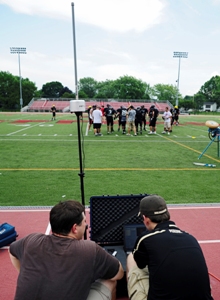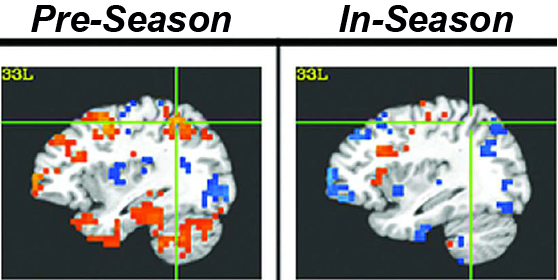Why, among players experiencing similar magnitude and number of blows to the head, so some sustained concussions and others do not. To answer the question, researchers at Purdue University followed a group of high school football players over the course of the two seasons:
- Pre-Season: In the week before "two-a-days" each season, the players (21 the first year, 28 the second, including 16 returning players) took baseline ImPACT tests (a computerized neurocognitive exam of memory and concentration), and underwent functional MRI (fMRI) tests, which measures working memory while their brains were being monitored with magnetic resonance imaging.
- In-Season:
- Monitored hits: Each player's helmet was equipped with sensors (accelerometers) which relayed d
 ata on head collisions wirelessly to equipment on the sidelines during each play using a Head Impact Telemetry (HITSTM) system:
ata on head collisions wirelessly to equipment on the sidelines during each play using a Head Impact Telemetry (HITSTM) system:
- The 21 players who participated in the study over the course of the season experienced 15,264 "collision events" (a motion/action during which at least one accelerometer registered a magnitude in excess of 14.4 g's of linear force) across 48 practices and games, or an average of 15.5 collision events per player per practice or game; and
- Among players who started for either the varsity or junior varsity, per player collision event totals ranged from a high of 1855 (38.6 events per session) to a low of 226 (4.7 events per session).
- Testing: Of the eleven players invited to undergo "In Season" assessment (ImPACT and fMRI testing), three had been diagnosed by the team physician with concussion, and eight had accrued an unusually large number of helmet collisions (150+, mostly in the 40 to 80 g range of linear force) or at least one high magnitude acceleration (more than 80g of force) during that week's practices and games.
- Monitored hits: Each player's helmet was equipped with sensors (accelerometers) which relayed d
- Post-Season: 10 of the 11 players who underwent In-Season assessment then returned 1-3 months after the season for "Post-Season" assessment (ImPACT and fMRI testing).
Comparing pre-season and in-season test results, the researchers found that players fell into three groups:
- Four who demonstrated no impairment/no change in neurological behavior comparing pre-season/in-season;
- Three who exhibited signs and symptoms of concussion and a clinical diagnosis of concussion, which neurological impairment was subsequently confirmed in neurocognitive (ImPACT) and fMRI tests; and
- Four who exhibited no symptoms of concussion but who nevertheless were found to have statistically significant reductions in their ImPACT scores for verbal and/or visual memory and significantly decreased fMRI activation levels in regions of the brain strongly associated with working memory.

The third group constituted a completely unexpected and previously unknown category of players who, though they displayed no clinically-observable signs of concussion, nevertheless showed measurable impairment of neurocognitive function (primarily visual working memory) on neurocognitive tests, as well as altered activation in neurophysiologic function on sophisticated brain imaging tests (fMRI).
Indeed, researchers found, the players with the most impaired visual memory skills were not those in the concussed group but from the group which, in the preceding week, had experienced a large number of subconcussive hits - around 150 hits - mostly in the 40 to 80 g range.
The Purdue researchers suspect that the functionally, but not clinically impaired group comprise players who experienced neurologic trauma arising from repeated, sub-concussive head collision events, each of which likely produces sub-clinical stress on neural tissue in the brain.
More concerning, "these players not only may be representative of the group associated with ‘unreported' concussions, but also are also likely to meet the criterion" for inclusion in a group which, because they suffer repetitive, sub-concussive blows to the head, may be at increased risk of further, long-term brain injury, such as CTE, said the study.
Linemen most at risk
The group of functionally, but not clinically impaired, players were also different from the group of concussed players in a number of important respects:
- They experienced a significantly higher total number of collision events than any other group;
- They were primarily linemen, who experienced helmet-to-helmet contact on nearly every play from scrimmage, often to the upper forehead above the facemask. "These are the kids who put their head down and take blow after blow to the top of the head," said Eric Nauman, assistant professor of biomedical engineering and basic medical sciences, who leads Purdue's Human Injury Research and Regenerative Technologies Laboratory. As a Sports Illustrated cover story on the study put it, "It wasn't the rare, excessively violent collision between the wide receiver and the free safety, the Patriot missile intercepting the Scud, that mattered most, but rather the milder, more frequent kind of hits that replicated two adolescent rams knocking heads."
The Purdue results are consistent with the findings of a 2010 study of college football players reported in the Journal of Athletic Training[2] that head-impact exposure differed significantly by position, with linemen (both offensive and defensive) and linebackers receiving more impacts per practice and games than other positions, while lineman, linebackers and defensive backs recieved more impacts to the front of the head than the back, with quarterbacks experiencing a higher pecentage of impacts to the back of the head compared with the front; and
- They experienced more higher magnitude (more than 80g) collision events directed to the top front of the helmet -impacting parts of the brain involved in working memory, including visual working memory, a form of short-term memory for recalling shapes and visual arrangement of objects such as the placement of furniture in a room - while the concussed players tended to take heavy, high velocity hits to the side of the helmet.
1. Talavage T, Nauman E, Breedlove E, et. al. Functionally-Detected Cognitive Impairment in High School Football Players Without Clinically-Diagnosed Concussion. J Neurotrauma. 2010; DOI: 10.1089/neu.2010.1512.
2.Talavage TM, Nauman EA, Breedlove EL, et al. Functionally-detected cognitive impairment in high school football players without clinically diagnosed concussion. J Neurotrauma. 2014;31(4):327-338. doi:10.1089/neu.2010.512.








